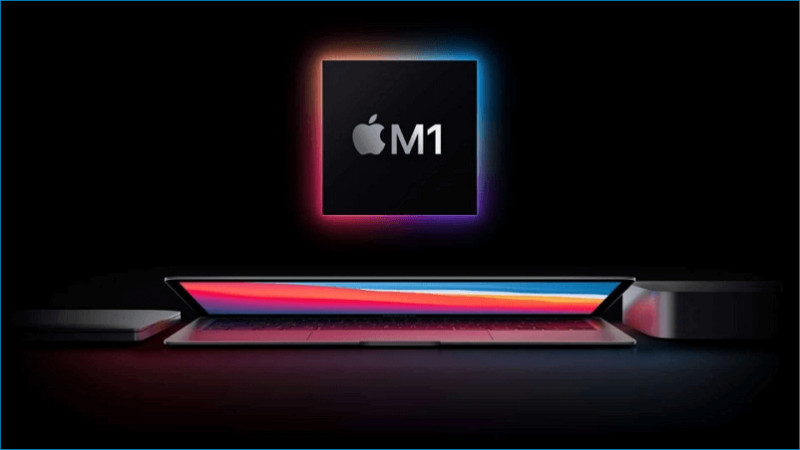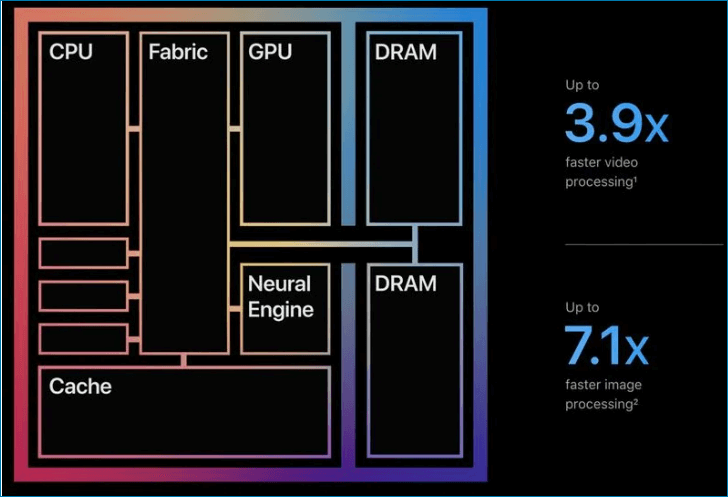Apple M1 Chip| An Apple Chip You Need to Know
A Brief Introduction about Macbook M1 Chip
The M1 chip marked Apple's first foray into creating a System on a Chip (SoC) specifically for Macs, a departure from the Intel processors used in Macs since 2006.

The M1 chip powers various Mac features as a "System on a Chip" by integrating components like the CPU, GPU, RAM, Neural Engine, Secure Enclave, SSD controller, image signal processor, encode/decode engines, and Thunderbolt controller with USB 4 support.
Apple's M1 Chip is faster and more effective than earlier Intel CPUs due to efforts to integrate processors. Unlike earlier Macs, which used multiple CPU, I/O, and security chips, the M1 has a unified memory architecture, allowing all technologies to access the same data without switching between different memory pools.

The Design of Apple Silicon M1 Chip
The M1 Chip's design stands out due to its unique combination of CPU, GPU, and memory features. It integrates a 4-core CPU, 8-core GPU, and 16-core Neural Engine, making it a powerful and efficient processor. The design also includes a 16-core Neural Engine, which provides advanced machine learning capabilities. The M1 Chip's design is optimized for low power consumption and high performance, making it suitable for a wide range of applications, from laptops to desktops and even servers.
CPU
An 8-The M1 Chip features a unified core CPU with four high-performance cores and four high-efficiency cores, optimized for delivering top performance for power-intensive single-threaded workloads.
The M1 Macs outperform even the most expensive 16-inch MacBook Pro versions due to the four powerful cores' exceptional multithreaded performance.
Four high-M1 chips have 4 high-performance cores and 4 high-efficiency cores. The high-efficiency cores use a tenth of the power for jobs that are less demanding, such as web browsing, to prolong battery life.
Apple's M1 chip has two high-performance cores and six high-efficiency cores, which provide comparable performance to a previous-generation MacBook Air but with significantly lower power consumption. The high-efficiency cores can operate independently for less demanding tasks, but all eight cores can work together for more demanding tasks.

GPU
The M1 includes an eight-The M1 GPU, created by Apple, consists of 16 Execution Units, each made up of 8 Arithmetic Logic Units (ALUs). This configuration enables the GPU to run up to 24,576 threads simultaneously and achieve a maximum floating point (FP32) speed of 2.6 TFLOPs. In total, the M1 GPU has up to 128 Execution units, or 1024 ALUs.
Memory
The M1 processor's components share a 128-bit LPDDR4X SDRAM. There are variants with 8 GB and 16 GB memory, and a system-in-package (SiP) design allows the RAM and SoC chips to be mounted side by side. This design enables efficient memory access and utilizes a single 128-bit memory interface.
Battery Life
The M1 Chip offers significant speed boosts while also being more energy-efficient than any other Mac chip Apple has created.
M1 Macs have significantly improved battery life, with some models lasting up to 20 hours, a notable increase from earlier generations.
macOS Big Sur is engineered to take full advantage of the M1 chip, resulting in a massive boost in performance, improved battery life, and enhanced security protections.
Apple M1 Speed
The M1 Chip offers significantly improved performance compared to previous-generation Intel CPUs, with up to 3.5x faster CPU speed, 6x faster GPU performance, and 15x faster machine learning capabilities. It also outpaces the most recent PC laptop CPUs by 2x, while consuming only 25% of the electricity.
Macbook M1 Chip vs. M1 Pro Chip vs. M1 Max Chip
Apple's MAC notebooks use Macbook chips such as the M1, M1 Pro, and M1 Max, giving them an unparalleled advantage over other notebooks. The main difference between these three chips lies in their processing power and capabilities, which can be summarized in a table.
M1 vs. M1 Pro vs. M1 Max - Specifications
| Design | M1 Chip | M1 Pro Chip | M1 Max Chip |
|---|---|---|---|
| CPU Cores (Total) | 8 | 8 or 10 | 10 |
| GPU Cores | 7 or 8 | 14 or 16 | 24 or 32 |
| Neural Engine Cores | 16 | 16 | 16 |
| Transistors | 16 billion | 33.7 billion | 57billion |
| Foundry process | 5nm | 5nm | 5nm |
| Unified Memory | 8GB | 16GB | 32GB |
| Capacities | 16GB | 32GB | 64GB |
| Memory Bandwidth | 68.25GB/s | 200GB/s | 400GB/ |
Apple now purchases its M-The M1 MAX chip is more powerful than the M1 Pro chip, which is more powerful than the M1 chip, all made by Taiwan Semiconductor Manufacturing Company (TSMC). The performance and price of these chips increase in that order.
Which Apple Products Use the M1 Chip
Apple's major products widely use the M1 Chip, which was one of their earliest chips. Next, we will introduce the Apple series products that use this chip.
| Product Name |
|---|
| MacBook Air (M1, 2020) – base model has 7-core GPU |
| Mac Mini (M1, 2020) |
| MacBook Pro (13-inch, M1, 2020) |
| iMac (24-inch, M1, 2021) – base model has 7-core GPU |
| iPad Pro, 11-inch (5th generation)(2021) |
| iPad Pro, 12.9-inch (5th generation)(2021) |
| iPad Air (5th generation)(2022) |
Products with the M1 Chip are more budget-friendly compared to those with the M1 Pro Chip and M1 MAX. If you're looking for a smooth and cost-effective Apple experience, these products are a good choice.
Conclusion:
With this guide, you now have a solid understanding of the Macbook M1 chip, M1 Pro Chip, and M1 MAX. You can confidently refer to this guide if you're in the market for related products.
Related Articles
- What Is Spindump Mac and How to Utilize It? [Complete Guide]
- Ways to Delete Windows 7 Backup [Updated 2022]
- Backup vs. Replication: Which One to Choose
- What Is Safe Mode On Windows And How To Enable It? [Full Guide]